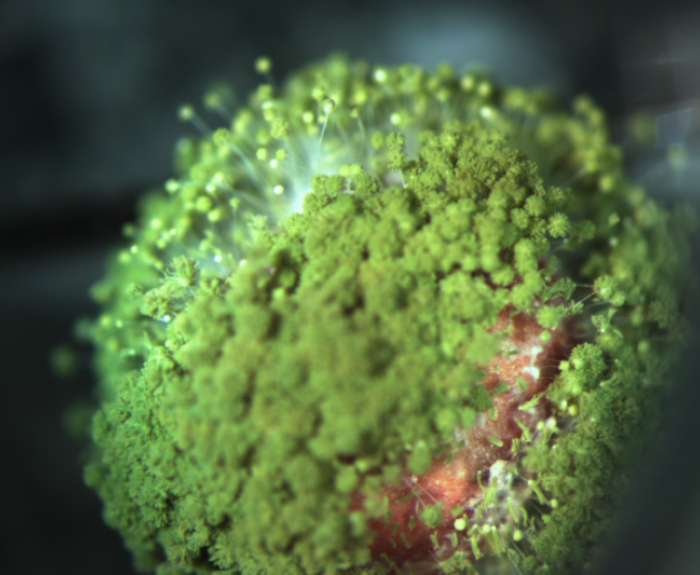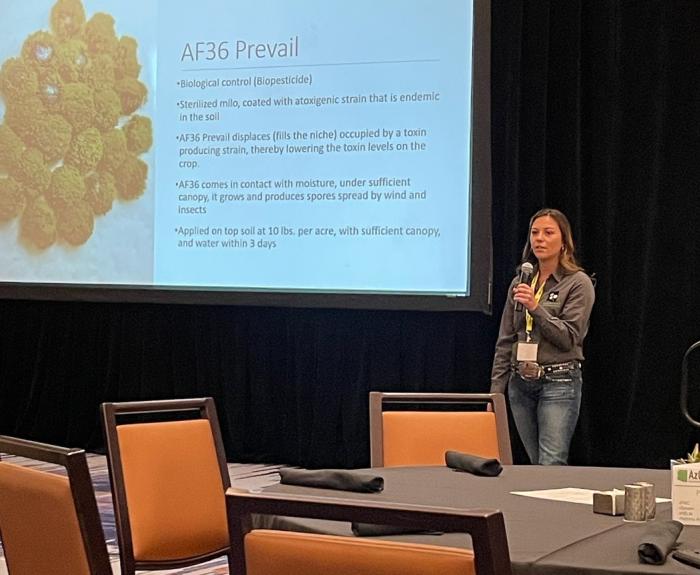AF36 Program
Proven Science. And Production.
Aspergillus flavus AF36 Prevail and AF36 Prime have established themselves as effective tools in managing aflatoxins by using a native strain of the fungus that naturally does not produce aflatoxins. The beneficial fungus (AF36) is coated onto a carrier grain that is sterilized and serves as a food source for the fungus. By applying AF36 Prevail or AF36 Prime (OMRI Organic) to crops at the appropriate time and moisture conditions, the fungus grows on the carrier grain and moves to the crop before the aflatoxin-producing strains have an opportunity to infect the crops.

The Problem
Aflatoxins are carcinogenic poisons produced by some strains of the common fungus (Aspergillus flavus) that contaminate crops throughout the world. Cotton, corn, peanuts, and several tree crops including almonds, pistachios and figs are just some of the crops susceptible to aflatoxin contamination.
Crops with aflatoxin content exceeding regulatory limits set by the FDA prevent these crops from entering premium markets and are at a severe trading disadvantage. Mycotoxins have cost USA crop producers annual losses ranging between $300 million and $1.7 billion.
Pictured left is AF36 Sporulation on milo in microscopic view

The Opportunity
Pioneering research conducted by the USDA-ARS identified certain native strains of Aspergillus flavus which do not contain aflatoxin. They occur naturally in soils at low levels.
One of these atoxigenic (non-toxin producing) strains, Aspergillus flavus AF36, has been shown to competitively displace aflatoxin-producing strains when applied. This displacement leads to reduced aflatoxin on applied crops.
From the initial evaluation period in Yuma, AZ in 1996 to present, AF36 applications and displacement levels are continually evaluated to ensure efficacy. Annual, area wide use has proven to optimize the fungal community in the soil, making the atoxigenic strain (AF36) the dominant soil occupant.
The Arizona Cotton Research and Protection Council (ACRPC) established a working partnership with USDA-ARS to both manufacture AF36 and advance atoxigenic strain technology.

The Solution
The biological control Aspergillus flavus AF36 Prevail has established itself as an effective tool in managing aflatoxins by using a native strain of the fungus that naturally does not produce aflatoxins.
The beneficial fungus, AF36, is coated onto a carrier grain that is sterilized (will not germinate) and serves as a food source for the fungus. By applying AF36 Prevail to crops at the appropriate time, the fungus grows on the carrier grain in the field, and moves to the desired crop before the aflatoxin-producing strains have an opportunity to infect the crops.
Using AF36 actually changes the composition of the fungi in the environment, shifting the majority of the population from aflatoxin producers to the safe, non-toxin producing strain of Aspergillus flavus.
The Journey
- June 1998: AF36 PRODUCT REGISTRATION - USDA ARS granted ACRPC a license to utilize USDA atoxigenic strain patents to control aflatoxin in Arizona cotton.
- July 1998: EUP DATA COLLECTION - Over 30,000 acres were treated in Arizona to contribute to EUP Data.
- September 1998: MANUFACTURING FACILITY DEVELOPMENT - ACRPC leased 15,000 square feet of building/warehouse space to house a prototype AF36 production facility plus associated labs and offices. Facility development has progressed to its current state which is capable of supplying commercial scale quantities of AF36 capable of treating more than 400,000 crop acres per season. This represents a multi-million-dollar investment on the part of the Arizona cotton industry.
- August 2000: BEE TOXICITY TESTING - Successful environmental studies conducted to ensure no harm to bees as prerequisites for Section 3 Registration.
- May 2002: AVIAN AND MAMMALIAN TESTS - were successfully completed as prerequisites for Section 3 Registration.
- July 2003: SECTION 3 EPA LABEL APPROVED - for AF36 for cotton in Arizona and Texas
- September 2006: LABEL EXPANSION - research interest from Texas Corn Producers Board funds research to expand use on corn.
- December 2010: LABEL AMENDMENT – The need for aflatoxin remediation in corn became prevalent as levels were unacceptable in the corn market. Commercial data was gathered, and the amendment was approved to add Corn to the Arizona AF36 label.
- November 2011: LABEL AMENDMENT – American Pistachio Growers were battling aflatoxin levels specifically in California. The amendment request was accepted by US EPA and California Department of Pesticide Regulation allowing another crop protection from aflatoxin.
- December 2014: CARRIER AMENDMENT – In an effort to increase distribution and efficiency, an amendment was made to change the carrier from wheat to milo. This allowed for more spore distribution points per carrier seed, and easier application due to a smaller seed size.
- August 2016: LABEL AMENDMENT – Almond and Figs in California needed an aflatoxin solution. AF36 was amended to include almond and figs on the US EPA label.
- Moving Forward: ACRPC is expanding to a larger production facility to accommodate demand and storage capacity. ACRPC now has five crops under protection in the Southwest United States. Inclusion of other crops and other geographic areas to protect them from the devastating losses of aflatoxin contamination is the mission of the AF36 Program.

